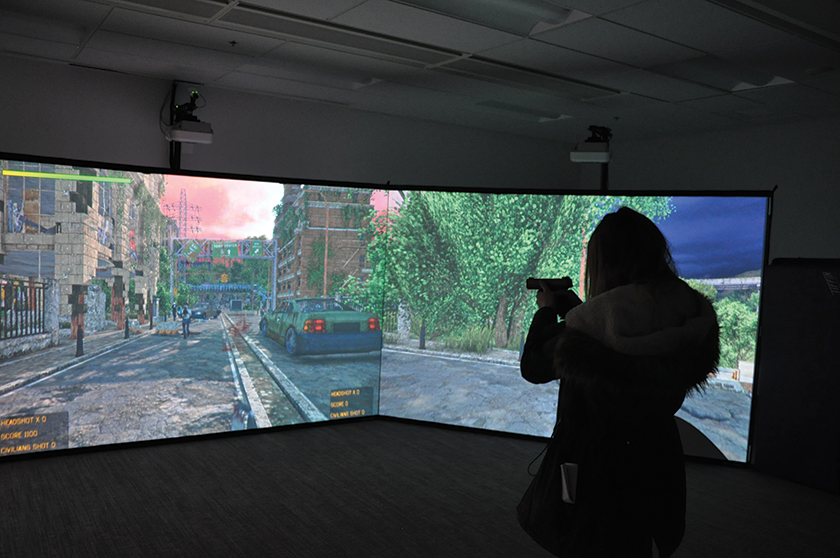Equipment List
A woman screams inside a home. The police follow through, as they’ve been trained to do. In another incident, there’s a fire in a six-story commercial building on the same lot. Fire and rescue are on the scene. However, it’s not a movie lot; rather, it’s a replicated Cityscape. There’s no director to yell, “Cut!”
These are examples of reality-based training scenarios—ranging from domestic violence, to barnstorming a building, to fire and rescue—at the Public Safety Training Academy (PSTA) at the Montgomery County Multi-Agency Service Park (MASP), in Gaithersburg MD. The recently completed $73.5 million update depends heavily on AV support inside classrooms and in the field. After classroom instruction, students follow through in simulated police, fire and rescue scenarios.
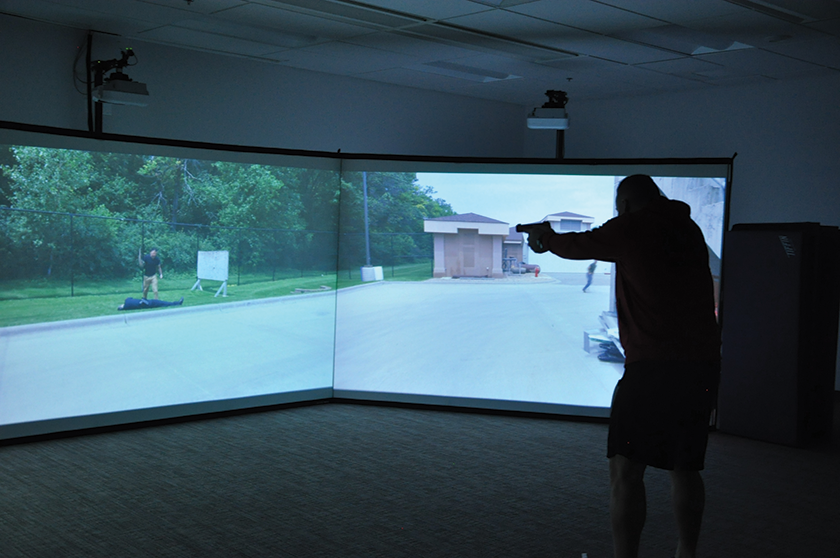
As you’ll find out, the woman’s scream from inside the house, delivered by a speaker, is just the tip of the iceberg for technology-intensive education and training. We’ll explore the facility’s purpose, operation and technology, as explained by design consultant spokespersons at Convergent Technologies Design Group (CTDG), while also discussing how training is carried out by police, fire and rescue services/EMS instructors.
Design Criteria
The overall design intent for the systems, and the infrastructure that supports it, was to provide Montgomery County with cutting-edge technology for the newly constructed complex. Therefore, previous gear, such as VCRs and 8-track tapes in classrooms, was updated with such advanced AV components as LCD projectors, LED flat-panel displays, wireless microphones and intercoms, and high-quality ceiling speakers. The systems have been designed to be turnkey and easy for instructors to operate. And, as mentioned, after traditional classroom introduction and training, real-world simulations on the training lot follow.
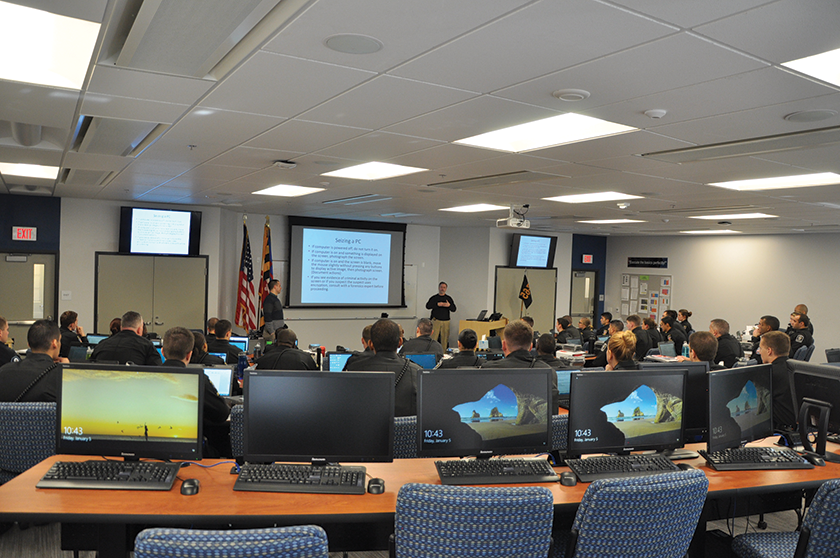
A brief aside: In writing this piece, I drew an analogy to grenade training in the Army. “Here’s a grenade,” the field training sergeant said. “You pull the pin. You throw the grenade onto the field. It goes ‘boom.’ Each of you take a grenade from the table and follow through.” That was called “Hands On Training” (HOT). Public safety training, however, requires a lot more sophistication, which invites AV support both inside and outside of the classroom.
To get the story about the PSTA, we turned to Bill Holaday, CTS-D, Principal, and Brian Whitlock, Project Manager, both of CTDG. We also got detailed user perspectives from fire and rescue/EMS spokesperson Capt. Lee R. Silverman, paramedic, EMS Training Officer, and Sgt. John Mullaney, Police Instructor, of PSTA. Special thanks to Rassa Davoodpour, Section Chief, Studio 4, Division of Building Design and Construction, Department of General Services, with Montgomery County, for supplying background information and securing interviews.
Overview
Holaday noted that CTDG designed not only the audiovisual systems, but also the security systems and telecommunications cabling systems for the project. “This is one of the benefits for the client having a firm such as ours designing all these systems,” he explained. “Instead of an AV package, a security package and a telecommunications package, they’re all working together. In some instances, it made sense to use the security cameras in an AV sense. The benefit to the client was the consolidated design of all these different systems.”
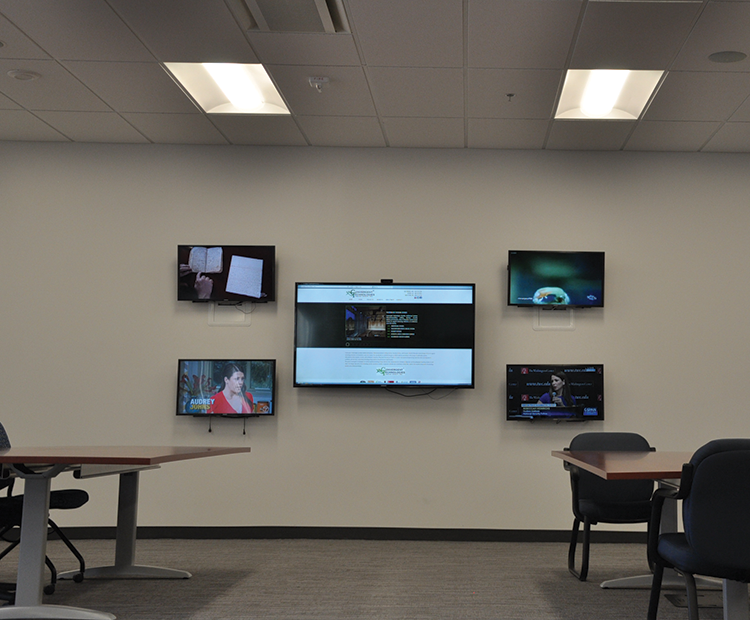
The Academy offers a true wealth of capabilities. It allows staff to provide scenario-based training for current law-enforcement officers, as well as new recruits, from the Montgomery County police and sheriff’s department, Gaithersburg city police, Tacoma Park police, the Department of Corrections, Chevy Chase village police and Montgomery County fire investigators. We’ll explore the fire-response and police aspects in considerable depth.
Among the new structures are a 117,000-square-foot, two-story academic building, as well as a police and fire Cityscape. In the Cityscape, there’s a two-story residence that’s designed for live training of various scenarios, such as domestic violence and house fires. Fire-event training scenarios, complete with natural gas-produced flames and theatrical fog effects, have a real-world feel. A six-story high rise further enables real-world public safety and fire-emergency training.
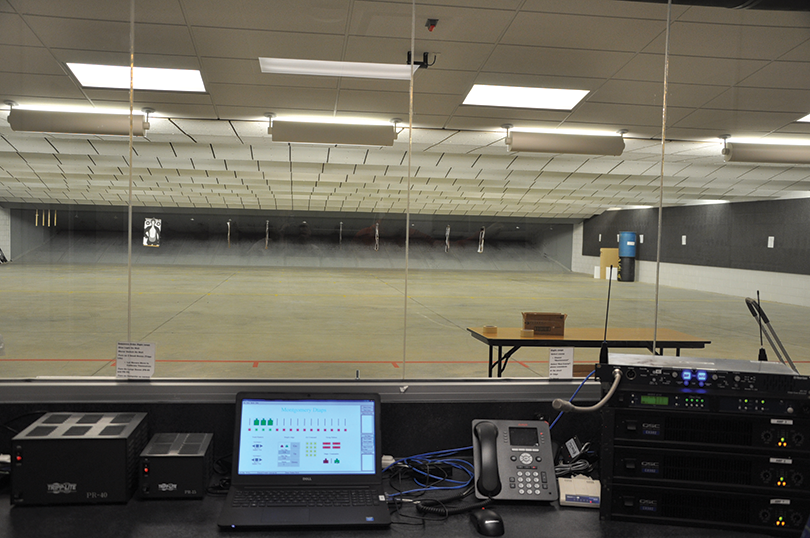
Talking about the installation itself, Whitlock, who managed the construction administration process for CTDG, affirmed, “It worked rather smoothly. No challenges on the install side.” The integrator on the project was SigTechS (Crofton MD). “The biggest challenge during design was to look forward and make sure we were planning infrastructure and pathways for future flexibility,” Holaday added. “So, we looked to capture the latest technologies, but also planned for future technologies, should things change during installation.”
Holaday highlighted the collaborative process between the design team and the decision makers from Montgomery County. He said, “As a design consultant, CTDG worked for the architect of record, Michael Baker International, as a design team. We worked with Montgomery County to identify all the requirements of the project, which included the AV basis of design, drawings and specifications, all of which went out to install bid.”
Academic Building
The academic building houses nearly a dozen standard classrooms, as well as four tiered and four divisible classrooms. Mediatech lecterns offer presenters auxiliary AV inputs to connect owner-furnished laptops at the work surface. In addition, rooms share an Elmo digital document camera on a portable cart. AV access is through a Crestron touchpanel with a custom user interface. Signal routing is via a Crestron DMPS-300-C DigitalMedia Presentation System 300. Speaking of the Crestron systems, Whitlock noted, “Looking at the user’s needs and available electronics, Crestron made for an efficient and streamlined system. It’s the central hub of each classroom. We use the efficiency of these all-in-one devices as far as inputs and outputs.”
Presentation material in classrooms is displayed via ceiling-mounted, 4,000-lumen Panasonic LCD projectors, which shine onto Draper screens. Classrooms are also equipped with wall-mounted flat-panel LED displays from Sharp. A variety of screen sizes—mostly 60-inch and 23-inch models—were installed in the classrooms, conference rooms and various surveillance monitoring sites. (The complex’s lobby, museum and gymnasium have flat-panel displays with local inputs, as well.)
Distance conferencing is done in the tiered classrooms using the room cameras and microphones. On the audio side, presenters use Shure wireless lapel microphones. Program audio is provided by JBL Control ceiling-mounted speakers distributed throughout the spaces.
The Second Floor
The second floor of the academic building is designated for fire and rescue and EMS paramedic training, which includes classrooms and CPR medic training. “Students usually get their classroom cognitive training through a PowerPoint presentation, videos we’ve produced or from YouTube,” Capt. Lee R. Silverman said. “After that, there’s a safety briefing to help them understand how to deal with emergencies.”
Silverman is also in charge of all video productions at the Academy. Three rooms are allocated for the video studio, which functions as a combined police and fire training area. “We’ve been creating more of our own videos,” he explained. “It’s better for people to see our department and how we do training. Every section has its own way of doing things slightly differently, so we’ve been making our own in-house videos to meet those needs.” Production equipment includes Sony HD cameras, lighting and a Mac with Final Cut Pro X editing.
Hands-On Training
“Let’s say we do automobile fire training today,” Silverman described. “The students would get classroom lectures ahead of the outside training. They’d learn the concepts of how to fight a fire that’s under the hood, in the passenger compartment or underneath the vehicle. The students would get all the cognitive training to begin with.” In addition, he noted, there are different tracks for different personnel, depending on their experience level. Accordingly, there are tracks for those who are just starting, and others for those already certified who are coming back for retraining. After classroom instruction, training continues outside.
Video cameras were selected for both inside and outside applications in training locations. Mobotix wide-view cameras with integrated microphones and Vicon V910 dome cameras were used, variously, in classrooms and for surveillance purposes. Amplifier distribution for inside and outside areas throughout the training area emanates, variously, from Extron, Lab.gruppen and QSC models.
Getting into the hands-on training, Silverman said, “[Trainees] get on the fire truck, leave the apparatus building and drive to the simulator. They practice either laying out the hose or pulling the hose off the engine and extinguishing the fire. They do that over and over again, so each person gets a chance to hold the nozzle. The whole time, they’ll be wearing breathing apparatus. It’s a lot of work pulling a changed hose line with 110 to 120lb. of pressure. It’s not easy.”
The complex has several different training buildings; we’ll detail how two burn structures are used. The six-story high rise has its concrete protected with fire tiles, so there’s no damage to the building. For safety, all fire created is natural-gas-fed. There are several scenarios within the high rise, including a kitchen set with a stove and other appliances. The simulated blaze can range from one floor to an inferno engulfing the whole building. “We can adjust the amount of fire or flame coming through,” Silverman explained. Theatrical fog is also used, to create smoke.
Similar Simulation
Fire in the two-level, single-family residence, complete with an attic and a garage, is simulated similarly. The blaze could be as small as a kitchen fire or something worse. Options include the previously referenced automobile on fire.
“Each person going through training gets the same scenarios and same type of training,” Silverman added. “We don’t want one person getting more training than another. That’s one of the reasons we use natural gas. If we were using wood to burn, the fires would be different every time.”
Let’s take a moment to discuss the EMS/paramedic program at the Academy. “We simulate medical calls, too,” Silverman said. “We have an ambu inside our building for the paramedics to practice on. We’re only one of two fire departments in the state of Maryland accredited to teach a paramedic program. We meet the same requirements as the University of Maryland and other universities that teach paramedic classes.”
When an instructor requests it, scenarios are recorded on video for later analysis back in the classroom. New recruits who come to the Academy for the 26-week course have a montage of their training recorded. Upon graduation, a video is made for them.
Police Training
The first floor of the academic building is designated for police department classrooms. “I help supervisors teach supervisors how to be better supervisors,” Sgt. John Mullaney, PSTA Police Instructor, stated. He noted that there are essentially three learner types: auditory and visual types are taught in a classroom setting, whereas kinesthetic learning involves “getting up and doing,” outside of the traditional classroom. PowerPoint presentations with animation and the Multiple Interactive Learning/Training Objectives (MILO) Range Theater system—the latter will be discussed later in this article—are adjuncts to AV-powered instruction.
Within the Academy, kinesthetic learning starts in the padded-floor defense-tactics training room. “It teaches people how to tackle correctly, without injuring yourself and not injuring the suspect,” Mullaney said. After training in the Academy building, students are actively involved in real-world scenarios in the Cityscape.
The main building has hands-on-training indoor firearms ranges. The static range has 15 lanes with stationary booths for shooters to walk into, with targets on moving rails. On the tactical range, meanwhile, shooters move around in a huge, open concrete room with the bullet trap at the back and yard markers. “We even have a garage door where you can bring in cars and SUVs and set up traffic stops,” Mullaney pointed out. “So, there are a lot of capabilities on this range.”
Clear-Com intercom systems are used on the two firing ranges. The static range has intercoms in each booth location, whereas the tactical range uses intercoms and distributed loudspeakers throughout, as shooters move back and forth, and up and down, within the range. The intercoms provide essential two-way communication between the control booth and the bays. Instructors also have wireless intercoms, enabling them to communicate with the control booth.
Into The Cityscape
The new Cityscape, located outside the main building, has several buildings, all built to code with plywood walls, instead of drywall. Structures include a townhouse with two one-story apartments, a single-family home, a bank, a 7-Eleven and a small school. In addition, there are also two metro subway cars and two CSX railroad train cars for additional training options.
“We utilize scenario-based learning with living role players as often as we can, because it helps bridge the book knowledge into practical application,” Mullaney said. “The scene could be domestic, where we give recruits police radios set on a training channel. We dispatch them on mock calls that will make them run 150 yards up a hill to get their heart rate up. Then, they’ll have to interact with role players on a domestic violence call. The role players are either officers, volunteers or interns for the police department.” A real Glock pistol is used with simulation, non-lethal training rounds.
Personnel in police and EMS training use Axon body cameras. Mullaney noted, “All of our 800-plus veteran patrol officers use the body cameras, which show 143 degrees of view.” The cameras store 64GB, with a record time of 70 hours. Expanding on the training application, Whitlock said, “The focus of the cameras is to observe in real time, as well as in playback scenarios for the educational benefit of the participants performing the tasks.” Discussing having officers’ handling of situations recorded and shown in the classroom, Mullaney added, “It’s of tremendous value. It can show that we told them to look to the left, but they looked to the right.”
Giving another example of the cameras’ utility, Mullaney brought up teaching personnel the correct procedures in a high-risk traffic stop. “How are you going to get the guy out of the car?” he asked rhetorically. “The simulation you see has one of the instructors doing it with a GoPro camera mounted on their head, [to give] an officer’s point of view. We can show tactilely how to order the guy out of the car and put him in a position of disadvantage.”
The Cityscape also has four video-surveillance cameras further to record training activities.
Immersive Environments
As previously mentioned, PSTA has a MILO Range Theater system on premises, which is used to create a more immersive training environment. The system is composed of three HD projectors that fire on three 180-degree viewing screens with surround-sound audio. Instructors sit in a control room behind the students, manipulating the scenario on the screens via a desktop computer. Although there are many pre-recorded scenarios from which to choose, users also have the ability to devise their own scenarios and upload them to the MILO Range Theater system.
Student officers in training interact with action on the panoramic screens. “The role player has a knife and the officer orders, ‘Drop the knife!’” Mullaney said. “We can make the guy drop the knife and comply, or we can make him hold the knife and come at the officer.” MILO allows officers to practice de-escalation techniques in an environment that forces them to maintain situational awareness in the same way they’ll have to do on the street. He added, “The technology allows us to track the use of deadly force and immediately review with each participant the choices they made, and the rationale for those choices.”
EQUIPMENT
Axon body cameras
2 Biamp Nexia SP DSP speaker processors
2 Clear-Com MS-704 4-channel main intercom rack stations
2 Clear-Com WBS-680/B4 2-channel wireless intercom base stations
1 Clear-Com WTR-680/B4 2-channel wireless transceiver beltpack
4 Clear-Com HS15 intercom headsets
15 Clear-Com KB-701 single-channel intercom speaker stations
4 Contemporary Research 232-ATSC+ HD TV tuners
4 Crestron DMPS-300-C DigitalMedia Presentation Systems
1 Crestron DM-RMC-100-C DigitalMedia 8G+ Receiver and Room Controller
8 Crestron DM-RMC-SCALER-C DigitalMedia 8G+ Receiver and Room Controllers w/scalers
1 Crestron DM-TX-200-C-2G Wall Plate DigitalMedia 8G+ Transmitter
2 Crestron DM-TX-201-C DigitalMedia 8G+ Transmitters
3 Crestron HD-DA-2 1-to-2 HDMI distribution amps and audio converters
1 Crestron HD-EXT1-C HDMI over shielded twisted pair extender
3 Crestron MPC-M10-B-T Media Presentation Controller M10s
4 Crestron TSW-750-B-S 7″ touchscreen
4 Crestron remote-control button panels
1 Elmo P10 digital document camera w/cart
4 Extron Cable Cubby 600 furniture-mountable enclosures
1 Extron MVC 121 Plus 3-input stereo mixer w/DSP
3 Extron XPA 2001 mono 70/100V amps (200W)
2 Extron XPA 2002 2-channel amps (200W per channel)
1 FAAC Inc. MILO Range Theater system
1 FSR CB 22P ceiling enclosure
4 Gefen EXT-USB2.0-LR USB 2.0 extenders
34 JBL Control 26CT ceiling-mounted speakers
28 JBL Control 28 surface-mounted speakers
4 Mediatech lecterns
2 Middle Atlantic ERK-1825 ERK Series racks (18RU, 25″D)
6 Mobotix wide-view cameras w/integrated mics
5 Panasonic PT-VW435NU 4,000-lumen LCD projectors w/mounts
7 QSC CX302V 2-channel 70V power amps
13 Sharp 60″ LC-60LE550U LED flat-panel displays w/mounts
4 Sharp 23″ LED flat-panel displays w/tuners and mounts
2 Shure MX418S/C gooseneck mics
5 Shure ULXP14/51 lavalier wireless mic systems
1 SMART Technologies SP518 18″ digital annotation device
12 Whirlwind custom audio/video I/O plates
List is edited from partial information supplied by Convergent Technologies Design Group.
